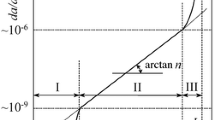Abstract
Fatigue crack growth is looked upon as an irreversible nondecreasing stochastic process. The suitability of several well-known distributions for describing the time for a crack to progress a specified amount is discussed relative to the coefficient of skewness. Based upon available data, it is shown that “weakest link” distributions that have appeared in the literature are not suitable. Further, it is demonstrated that to the contrary, “strongest link” distributions are consistent with the data. Finally, implications for stochastic models of fatigue crack growth are discussed.
Similar content being viewed by others
References
J. L. Bogdanoff and F. Kozin:Engng. Fract. Mech., 1984, vol. 20,, no. 2 pp. 255–70.
H. Cramer:Mathematical Methods in Statistics, Princeton Univ. Press, Princeton, NJ, 1951, Section 15.8.
F. Kozin and J.L. Bogdanoff:Engng. Fract. Mech., 1983, vol. 18, no. 3, pp. 623–32.
H. Cramer:Mathematical Methods in Statistics, Princeton Univ. Press, Princeton, NJ, 1951, Sections 27.4 and 27.9.
G. J. Hahn and S. S. Shapiro:Statistical Models in Engineering, John Wiley & Sons, New York, NY, 1967.
N. L. Johnson and S. Kotz:Distributions in Statistics—Univariate Case, Houghton Mifflin Co., Boston, MA, 1970.
N. R. Mann, R. E. Schafer, and N. D. Singpurwalla:Methods for Statistical Analysis of Reliability and Life Data, John Wiley & Sons, New York, NY, 1974.
E. J. Gumbel:Statistic of Extremes, Columbia Univ. Press, New York, NY, 1958.
D. A. Virkler, B. M. Hillberry, and P.K. Goel: AFFDL-TR-78-43, April 1978.
S. J. Hudak, A. Saferra, R. J. Bucci, and R. C. Malcolm: AFML-TR-78-40 (Data courtesy of ASTM E24.04.01 Comm.), 1978.
M. Ichikawa, M. Hamaguchi, and T. Nakamura:Journ. Soc. Mat. Sc. (Japan), Jan. 1984, vol. 33, no. 364, pp. 8–18.
J. W. Cohen: Lecture, NATO Conference, Reliability Testing and Reliability Evaluation, The Hague, 1972.
J. L. Bogdanoff and F. Kozin: ASME, 1984, AMD-vol. 65, pp. 1-7.
J. L. Bogdanoff and F. Kozin:Probabilistic Models of Cumulative Damage, John Wiley & Sons, New York, NY, 1985.
Author information
Authors and Affiliations
Additional information
This paper is based on a presentation made at the symposium “Stochastic Aspects of Fracture” held at the 1986 annual AIME meeting in New Orleans, LA, on March 2-6, 1986, under the auspices of the ASM/MSD Flow and Fracture Committee.
Rights and permissions
About this article
Cite this article
Kozin, F., Bogdanoff, J.L. Role of third order statistics in discriminating among models of fatigue crack growth in metals. Metall Trans A 18, 1855–1859 (1987). https://doi.org/10.1007/BF02647015
Issue Date:
DOI: https://doi.org/10.1007/BF02647015




